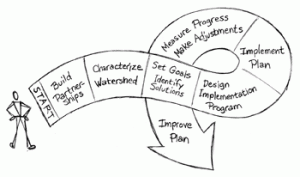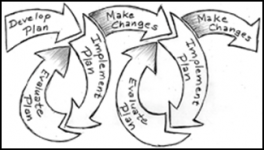Watershed Management & Planning
The Watershed as a Management Approach
A watershed is the land area extending from the topographic high points where water collects, such as ridges, down to the topographic low point where the area drains into a creek, river, bay, ocean, or other waterbody. Watershed management is the integration and coordination of activities that affect the watershed's natural resources and water quality. The premise of this concept is that many water quality and ecosystem problems are best prioritized, addressed, and solved at the watershed level rather than at the individual waterbody level. Major features of a watershed management approach are targeting priority problems, promoting a high level of stakeholder involvement, developing integrated solutions that make use of the expertise and authority of multiple agencies and organizations, and measuring success through monitoring and other data gathering. (SF Bay RWQCB, 2004)
The Watershed Planning Process
 Since the late 1980s, organizations and agencies have moved toward managing water quality by using a watershed approach, which includes stakeholder involvement and management actions supported by sound science and appropriate technology. The watershed planning process works within this framework to identify and quantify specific causes and sources of water quality problems. It also identifies water quality goals and specific actions required to solve water resource challenges.
Since the late 1980s, organizations and agencies have moved toward managing water quality by using a watershed approach, which includes stakeholder involvement and management actions supported by sound science and appropriate technology. The watershed planning process works within this framework to identify and quantify specific causes and sources of water quality problems. It also identifies water quality goals and specific actions required to solve water resource challenges.
A watershed plan is a strategy and a work plan for achieving water resource goals that provides assessment and management information for a geographically defined watershed. It includes the analyses, actions, participants, and resources related to development and implementation of the plan. The watershed planning process uses a series of cooperative, iterative steps to characterize existing conditions, identify and prioritize problems, define management objectives, and develop and implement protection or remediation strategies as necessary.
US EPA has made available a document to help communities, watershed organizations, and local, state, tribal, and federal environmental agencies develop and implement watershed plans. The Handbook for Developing Watershed Plans to Restore and Protect Our Waters (March 2008) is designed to help anyone undertaking a watershed planning effort, but should be particularly useful to persons working with impaired (e.g., polluted) or threatened waters. The handbook should be used to supplement the many good watershed planning guides developed by other agencies, universities, and nonprofit organizations. It contains in-depth guidance to meet water quality standards, develop effective management measures, and track progress once the plan is implemented.
 Watershed assessment, planning, and management are iterative processes, and targeted actions might not result in complete success during the first or second cycle. Adjustments must be made along the way to continue progress toward attaining established water resource goals.
Watershed assessment, planning, and management are iterative processes, and targeted actions might not result in complete success during the first or second cycle. Adjustments must be made along the way to continue progress toward attaining established water resource goals.
Watershed planning recognizes that even if reasonable steps are taken to obtain and analyze relevant data, the information available during the planning stage (within reasonable time and cost constraints) might be limited. The watershed planning process should be implemented in a dynamic and adaptive manner to ensure that implementation of the plan can proceed even though some of the information in the watershed plan is imperfect and might need to be modified or improved upon over time as better information becomes available. Long-term monitoring of watershed resources and their response to implementation actions identified in the plan is vital (US EPA, 2010).

